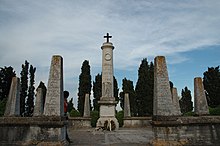Battle of Castelfidardo
| date | September 18, 1860 |
|---|---|
| place | Castelfidardo , Marche , Papal States (now Italy ) |
| output | Victory of the Kingdom of Sardinia |
| Parties to the conflict | |
|---|---|
|
|
| Commander | |
| Troop strength | |
| 39,000 men | 10,000 men |
| losses | |
|
61 dead |
88 dead, |
In the battle of Castelfidardo on September 18, 1860, the Piedmontese troops of General Enrico Cialdini defeated the papal troops of Generals De Pimodan and Lamoricière near Castelfidardo ( Ancona ) . Although it was one of the smaller battles of the Sardinian War (also known as the "Second Italian War of Independence ") from 1859 to 1860, its outcome was of great importance, as it resulted in the union of the Kingdom of Sardinia-Piedmont with that of Garibaldi in his " Train of a Thousand " conquered Kingdom of Naples became possible. King Victor Emmanuel II annexed large parts of the Papal States ( Marche , Umbria , but not Rome and Latium ) and united almost all of Italy under the crown of the House of Savoy . The French intervention hoped for by the Pope failed to materialize thanks to the diplomatic work of the Piedmontese Prime Minister Cavour and the temporary renunciation of the occupation of Rome.
Course of the battle
The Piedmontese army moved to southern Italy with two corps and five divisions . The IV Corps under Cialdini comprised the 4th, 7th and 13th Divisions, the V Corps under General Della Rocca led the 1st and the reserve divisions. In total, there were 39,000 soldiers, 2,500 horses and 77 cannons . General Manfredo Fanti was the commander of this armed force known as the “Marken and Umbria Army” . He was supposed to "assist" Garibaldi in the south. After the Battle of the Volturno , Garibaldi had to be clear that he could not assert any political claims for himself.
The papal army under the command of French General Christophe de Lamoricière defended the Papal States with the following powers: 1. Brigade (General Schmidt) in Foligno , 2nd Brigade (De Pimodan) in Terni , 3rd Brigade (De Courten) in Macerata , Reserve Brigade (Cropt) in Spoleto . In total, this mobile force had 10,000 men and 30 cannons. In addition there were the territorial forces in the larger cities, in this case the approximately 10,000 soldiers of Ancona .
The Piedmontese advanced along the Adriatic coast with the IV Corps , the V Corps reached the Tiber Valley inland in order to cut off a possible retreat to Rome from the papal troops and force them to a decisive battle in which the Piedmontese theirs numerical superiority.
In anticipation of an Austrian or French intervention, however, Lamoricière marched with his mobile forces on Ancona in order to threaten the sector of the IV Piedmontese Corps.
The IV Corps occupied Pesaro , Urbino , Fano and reached Senigallia . In order to forestall an advance Lamoricière on Ancona, Cialdini occupied the important mountain ranges of Osimo and Castelfidardo. They attacked Lamoricière and Pimodan on the morning of September 18, 1860. The Piedmontese Bersaglieri initially slowed this "papal storm" and then went over to counterattack together with other infantry units . Between S. Casa di Sopra and S. Casa di Sotto there were repeated vigorous attacks on the mountain ranges by Lamoricière and his troops, which led to hand-to-hand combat with bayonets . The battle of Castelfidardo initially remained local, only a few thousand soldiers were involved in the fighting. The papal troops, however, sought a quick local victory in view of the Piedmontese superiority and fought with appropriate force. Cialdini soon brought in reinforcements, which led to a quick end to the battle. After a few days of siege, the Ancona fortress also surrendered. The way south was free for the Piedmontese.
The circumstances of the battle of Castelfidardo are described in the papal allocation Novos et ante . According to the Pope's words, the Piedmontese troops are said to have advanced to the provinces of Picenum and Umbria on the pretext of driving out rioters .
See also
literature
- AA.VV. "Il marchese Giorgio Pimodan, generale della Santa Sede, morto nella battaglia di Castelfidardo". Roma, H. Gigli, 1860.
- Romano (pseud.); "Narrazione delle battaglia di Castelfidardo e dell'assedio d'Ancona". Italia, 1862.
- Attilio Vigevano; "La campagna delle Marche e dell'Umbria". Roma, staff. poligrafico, 1923.


